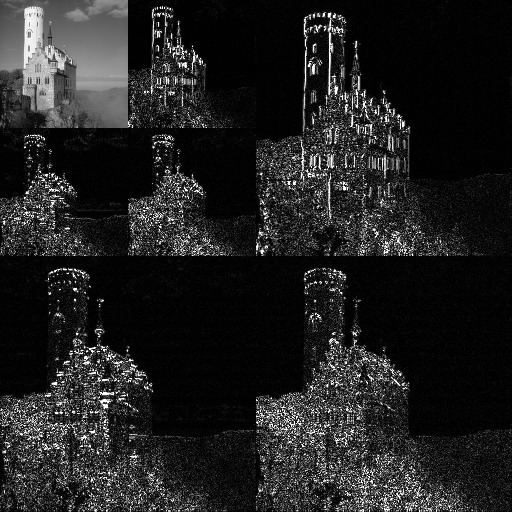 | ||
In mathematics, a wavelet series is a representation of a square-integrable (real- or complex-valued) function by a certain orthonormal series generated by a wavelet. Nowadays, wavelet transformation is one of the most popular time-frequency-transformations. This article provides a formal, mathematical definition of an orthonormal wavelet and of the integral wavelet transform.
Contents
Definition
A function
The Hilbert basis is constructed as the family of functions
for integers
If under the standard inner product on
this family is orthonormal, it is an orthonormal system:
where
Completeness is satisfied if every function
with convergence of the series understood to be convergence in norm. Such a representation of a function f is known as a wavelet series. This implies that an orthonormal wavelet is self-dual.
The integral wavelet transform is the integral transform defined as
The wavelet coefficients
Here,
Principle
The fundamental idea of wavelet transforms is that the transformation should allow only changes in time extension, but not shape. This is effected by choosing suitable basis functions that allow for this. Changes in the time extension are expected to conform to the corresponding analysis frequency of the basis function. Based on the uncertainty principle of signal processing,
where t represents time and ω angular frequency (ω = 2πf, where f is temporal frequency).
The higher the required resolution in time, the lower the resolution in frequency has to be. The larger the extension of the analysis windows is chosen, the larger is the value of
When Δt is large,
- Bad time resolution
- Good frequency resolution
- Low frequency, large scaling factor
When Δt is small
- Good time resolution
- Bad frequency resolution
- High frequency, small scaling factor
In other words, the basis function Ψ can be regarded as an impulse response of a system with which the function x(t) has been filtered. The transformed signal provides information about the time and the frequency. Therefore, wavelet-transformation contains information similar to the short-time-Fourier-transformation, but with additional special properties of the wavelets, which show up at the resolution in time at higher analysis frequencies of the basis function. The difference in time resolution at ascending frequencies for the Fourier transform and the wavelet transform is shown below.
This shows that wavelet transformation is good in time resolution of high frequencies, while for slowly varying functions, the frequency resolution is remarkable.
Another example: The analysis of three superposed sinusoidal signals
Wavelet compression
Wavelet compression is a form of data compression well suited for image compression (sometimes also video compression and audio compression). Notable implementations are JPEG 2000, DjVu and ECW for still images, CineForm, and the BBC's Dirac. The goal is to store image data in as little space as possible in a file. Wavelet compression can be either lossless or lossy.
Using a wavelet transform, the wavelet compression methods are adequate for representing transients, such as percussion sounds in audio, or high-frequency components in two-dimensional images, for example an image of stars on a night sky. This means that the transient elements of a data signal can be represented by a smaller amount of information than would be the case if some other transform, such as the more widespread discrete cosine transform, had been used.
Discrete wavelet transform has been successfully applied for the compression of electrocardiograph (ECG) signals In this work, the high correlation between the corresponding wavelet coefficients of signals of successive cardiac cycles is utilized employing linear prediction.
Wavelet compression is not good for all kinds of data: transient signal characteristics mean good wavelet compression, while smooth, periodic signals are better compressed by other methods, particularly traditional harmonic compression (frequency domain, as by Fourier transforms and related).
See Diary Of An x264 Developer: The problems with wavelets (2010) for discussion of practical issues of current methods using wavelets for video compression.
Method
First a wavelet transform is applied. This produces as many coefficients as there are pixels in the image (i.e., there is no compression yet since it is only a transform). These coefficients can then be compressed more easily because the information is statistically concentrated in just a few coefficients. This principle is called transform coding. After that, the coefficients are quantized and the quantized values are entropy encoded and/or run length encoded.
A few 1D and 2D applications of wavelet compression use a technique called "wavelet footprints".
Comparison with Fourier transform and time-frequency analysis
Wavelets have some slight benefits over Fourier transforms in reducing computations when examining specific frequencies. However, they are rarely more sensitive, and indeed, the common Morlet wavelet is mathematically identical to a short-time Fourier transform using a Gaussian window function. The exception is when searching for signals of a known, non-sinusoidal shape (e.g., heartbeats); in that case, using matched wavelets can outperform standard STFT/Morlet analyses.
Other practical applications
The wavelet transform can provide us with the frequency of the signals and the time associated to those frequencies, making it very convenient for its application in numerous fields. For instance, signal processing of accelerations for gait analysis, for fault detection, for design of low power pacemakers and also in ultra-wideband (UWB) wireless communications.
